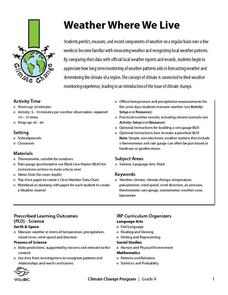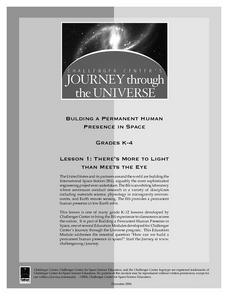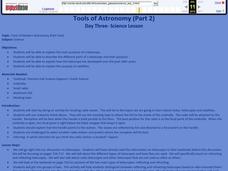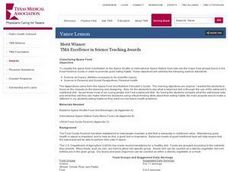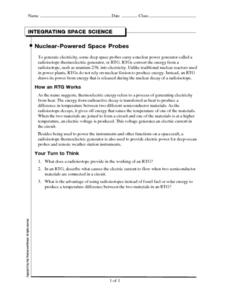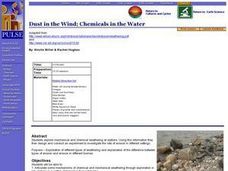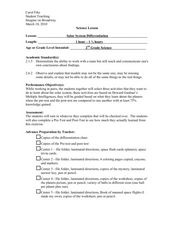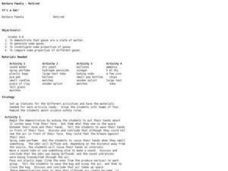Curated OER
Force and Motion
Students experiment with force and motion. In this force and motion instructional activity, students test gravity using a variety of objects. Students rotate through a series of stations which use force, motion, friction, and inclines....
Curated OER
Discover Magazine: The Solar System
Students research ideas for NASA's space exploration. For this Space Science lesson plan, students will try to find a way to bring NASA back into the spot light. Students will presented their ideas to the class for review.
Curated OER
The Solar System
Students examine the solar space program and research what options are the most viable. In this solar system lesson students view a video on the solar system, research the Internet and make recommendations.
Curated OER
Silicate Gardens
Students take digital pictures of their Silicate Gardens as an analysis of measurements of silicate tube growth. In this silicate measurements lesson plan, students download pictures of Silicate Gardens being grown on the International...
NASA
Lava Layering
Take the old baking soda and vinegar volcano to the next level by using it to study repeated lava flows over time, examine geologic features on Earth and Mars, and speculate about some of the formations on Mars.
Curated OER
Invertebrate Diversity
Comparative anatomy prevails in the lesson exploring diversity among invertebrates. Biologists examine physical characteristics of an earthworm from phylum annelida and a meal worm from phylum insecta. They also inspect a cricket and a...
NASA
The Discovery of Jupiter Radio Waves
Lead your class on a journey to the planet Jupiter and provide them with fun facts in the process. Learners explore radio waves emitted by Jupiter to further understand how this data helps our daily lives. They conclude by discussing...
Wild BC
Weather Where We Live
Over a span of two weeks or more, mini meteorologists record weather-related measurements. What makes this particular resource different from others covering similar activities are the thorough details for the teacher and printables for...
Laboratory for Atmospheric and Space Physics
Goldilocks and the Three Planets
Venus is the second brightest object in the night sky after the moon. Here is an interesting instructional activity that explores three planets — Venus, Earth, and Mars — specifically their surfaces and atmospheres. Through an analysis...
Curated OER
Write a Space Poem
Pupils write a variety of space travel poems that will be used to compile a class book and draw their own rocket and half fill it with words associated with space travel and add design and color.
Curated OER
There's More to Light than Meets the Eye
Students explore the concept that not all light is visible to the
human eye. Although UV light is not visible, it can still be harmful, causing sunburns or skin cancer. They use special beads to detect UV light around the school....
Curated OER
Digestive System
Students analyze how the digestive system works by taking the food we eat and breaking it down for our bodies to use for various reasons. They list the major components of the digestive system and draw a diagram. They explain how...
Curated OER
#24 Rotating Frames of Reference in Space and on Earth
Students explore rotating frames of reference, focusing on the weightless environment in space and the Coriolis force.
Curated OER
Tools of Modern Astronomy
Students differentiate refracting and reflecting telescopes. In this earth science lesson, students explain how they are closely connected to satellites. They complete the concept map at the end of the activity.
Curated OER
Space Exploration
Young scholars explore different planets of our solar system. Students gather specific information on each of the planets. Young scholars choose suitable planet for colonization.
Curated OER
Classifying Space Food
Students write a written summary of what they have learned about the astronaut nutritional diet in comparison with their own diet habits.
Curated OER
Nuclear-Powered Space Probes
For this space probes worksheet, students read about radioisotope thermoelectric generators and how they work. Then students complete 3 short answer questions.
Curated OER
WEAVING TECHNOLOGY INTO THEMATIC UNITS T.O.O.L.S. 2000
Third graders utilize computers and other technology to explain the solar system. Ten different stations involve students through laserdisc, research, art, GeoSafari, space toys, and the computer.
Curated OER
Dust in the Wind; Chemicals in the Water
Students explore mechanical and chemical weathering at stations. They articulate some mechanisms of chemical and mechanical weathering through exploration in a lab. Students stations describe how chemical weathering differs from...
Curated OER
Magnets
Students demonstrate the process of science by posing questions and investigating phenomena through language, methods and instruments of science as they experiment at four teacher-created stations to explain the fundamentals of magnetism.
Curated OER
Sig Fig/Measuring Lab
In this significant figure worksheet, students read six diagrams of a graduated cylinder to the proper number of significant figures. They then go to twelve lab stations and record the proper measurement to the appropriate number of...
Curated OER
Solar System Differentiation
Students explore the solar system. In this solar system science instructional activity, students choose 3 out of 12 centers to visit, each of which contains an activity related to the planets. The station activities are designed to...
Curated OER
It's a Gas!
Students investigate gases and their properties by completing 4 activities. In this gases lesson plan, students perform activities to show that gases take up space, they diffuse, and that odors and vibrations pass through gases. They...
Curated OER
Weather
Students explore the earth's atmosphere, weather, and climate. They begin class with a discussion about weather patterns, atmosphere, and the layers of the earth. After the class discussion, students rotate through four stations to...









